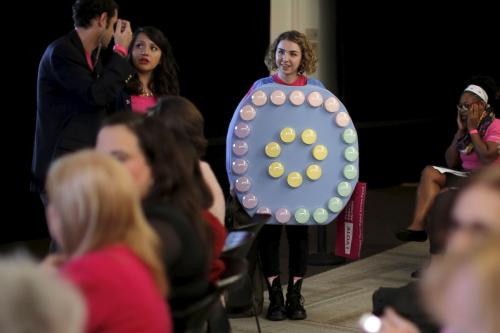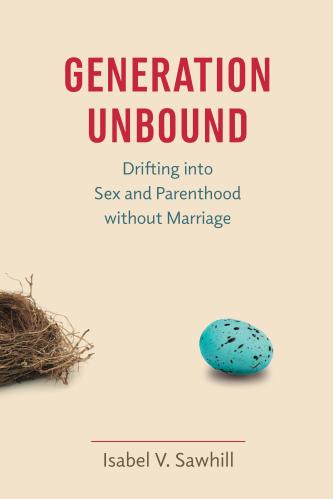In 1970 a permanent cure to poverty in America seemed on the horizon. Federal poverty warriors appeared to be gaining ground, and decisions by state courts regarding abortion and by state legislatures regarding the availability of contraception seemed to be giving poor families the tools to control the number and the timing of their children. The dream of eliminating poverty, however, has remained unfulfilled. Not only have U.S. poverty rates stayed stubbornly constant over the intervening 25 years, but also poor families have seen their lot worsen as huge increases in single-parent families more and more headed by unmarried mothers have led to the feminization of poverty in America.
Since 1970, out-of-wedlock birth rates have soared. In 1965, 24 percent of Black infants and 3.1 percent of white infants were born to single mothers. By 1990 the rates were 64 percent for Black infants, 18 percent for whites. Every year one million more children are born into fatherless families. If we have learned any policy lesson well over the past 25 years, it is that for children living in single-parent homes, the odds of living in poverty are great. The policy implications of the increase in out-of-wedlock births are staggering.
Searching for an Explanation
Efforts by social scientists to explain the rise in out-of-wedlock births have so far been unconvincing, though several theories have a wide popular following. One argument that appeals to conservatives is that of Charles Murray, who attributes the increase to overly generous federal welfare benefits. But as David Ellwood and Lawrence Summers have shown, welfare benefits could not have played a major role in the rise of out-of-wedlock births because benefits rose sharply in the 1960s and then fell in the 1970s and 1980s, when out-of-wedlock births rose most. A study by Robert Moffitt in 1992 also found that welfare benefits can account for only a small fraction of the rise in the out-of-wedlock birth ratio.
Liberals have tended to favor the explanation offered by William Julius Wilson. In a 1987 study, Wilson attributed the increase in out-of-wedlock births to a decline in the marriageability of Black men due to a shortage of jobs for less educated men. But Robert D. Mare and Christopher Winship have estimated that at most 20 percent of the decline in marriage rates of Blacks between 1960 and 1980 can be explained by decreasing employment. And Robert G. Wood has estimated that only 3-4 percent of the decline in Black marriage rates can be explained by the shrinking of the pool of eligible Black men.
Yet another popular explanation is that single parenthood has increased since the late 1960s because of the change in attitudes toward sexual behavior. But so far social scientists have been unable to explain exactly how that change came about or to estimate in any convincing way its quantitative impact. In recent work we have been able to provide both.
The Answer: No More Shotgun Marriages
In the late 1960s and very early 1970s (well before Roe v. Wade in January 1973) many major states, including New York and California, liberalized their abortion laws. At about the same time it became easier for unmarried people to get contraceptives. In July 1970 the Massachusetts law prohibiting the distribution of contraceptives to unmarried people was declared unconstitutional. We have found that this sudden increase in the availability of both abortion and contraception–we call it a reproductive technology shock–is deeply implicated in the increase in out-of-wedlock births. Although many observers expected liberalized abortion and contraception to lead to fewer out-of-wedlock births, the opposite happened–because of the erosion in the custom of shotgun marriages.
Until the early 1970s, shotgun marriage was the norm in premarital sexual relations. The custom was succinctly stated by one San Francisco resident in the late 1960s: If a girl gets pregnant you married her. There wasn’t no choice. So I married her.
Since 1969, however, the tradition of shotgun marriage has seriously eroded (see table 1 for the trend from 1965 through 1984). For whites, in particular, the shotgun marriage rate began its decline at almost the same time as the reproductive technology shock. And the decline in shotgun marriages has contributed heavily to the rise in the out-of-wedlock birth rate for both white and Black women. In fact, about 75 percent of the increase in the white out-of-wedlock first-birth rate, and about 60 percent of the Black increase, between 1965 and 1990 is directly attributable to the decline in shotgun marriages. If the shotgun marriage rate had remained steady from 1965 to 1990, white out-of-wedlock births would have risen only 25 percent as much as they have. Black out-of-wedlock births would have increased only 40 percent as much.
| Table 1. America’s reproductive technology shock | ||||
|---|---|---|---|---|
| 1965-69 | 1970-74 | 1975-79 | 1980-84 | |
| Births (thousands) | ||||
| Total | 3,599 | 3,370 | 3,294 | 3,646 |
| White | 2,990 | 2,760 | 2,660 | 2,915 |
| Black | 542 | 583 | 540 | 590 |
| Birthrates per 1,000 married women, age 15-44 | ||||
| White | 119.4 | 103.6 | 93.1 | 94.5 |
| Black | 129.1 | 110.3 | 93.3 | 90.6 |
| Birthrates per 1,000 unmarried women, age 15-44 | ||||
| White | 12.7 | 12.6 | 13.7 | 18.9 |
| Black | 91.0 | 94.6 | 85.5 | 81.7 |
| Women married, age 15-44 (percent) | ||||
| White | 67.8 | 65.3 | 61.6 | 58.8 |
| Black | 55.9 | 52.9 | 45.2 | 39.9 |
| Out-of-wedlock births (thousands) | ||||
| Total | 322 | 406 | 515 | 715 |
| White | 144 | 166 | 220 | 355 |
| Black | 189 | 230 | 280 | 337 |
| Women age 16 with sexual experience (percent) | ||||
| White | 13.8 | 23.2 | 28.1 | 32.8 |
| Black | 35.0 | 42.3 | 50.8 | 49.9 |
| Unmarried women using the pill at first intercourse (percent) | ||||
| Total | 5.7 | 15.2 | 13.4 | NA |
| Abortions, unmarried women, age 15-44 (thousands) | ||||
| Total | 88 | 561 | 985 | 1,271 |
| First birth shotgun marriage rate (percent) | ||||
| White | 59.2 | 55.4 | 45.7 | 42.0 |
| Black | 24.8 | 19.5 | 11.0 | 11.4 |
| Adoptions (thousands) | ||||
| Total | 158 | 156 | 129 | 142 |
| Ratio of adoptions to births to mothers not married within three years of birth | ||||
| Total | 49.0 | 38.4 | 29.0 | 19.8 |
| George A. Akerlof, Janet L. Yelln, and Michael L. Katz, “An Analysis of Out-of-Wedlock Childbearing in the United States,” Quarterly Journal of Economics, May 1996 | ||||
What links liberalized contraception and abortion with the declining shotgun marriage rate? Before 1970, the stigma of unwed motherhood was so great that few women were willing to bear children outside of marriage. The only circumstance that would cause women to engage in sexual activity was a promise of marriage in the event of pregnancy. Men were willing to make (and keep) that promise for they knew that in leaving one woman they would be unlikely to find another who would not make the same demand. Even women who would be willing to bear children out-of-wedlock could demand a promise of marriage in the event of pregnancy.
The increased availability of contraception and abortion made shotgun weddings a thing of the past. Women who were willing to get an abortion or who reliably used contraception no longer found it necessary to condition sexual relations on a promise of marriage in the event of pregnancy. But women who wanted children, who objected to abortion for moral or religious reasons, or who were unreliable in their use of contraception found themselves pressured to participate in premarital sexual relations without being able to exact a promise of marriage in case of pregnancy. These women feared, correctly, that if they refused sexual relations, they risked losing their partners. Sexual activity without commitment was increasingly expected in premarital relationships.
Advances in reproductive technology eroded the custom of shotgun marriage in another way. Before the sexual revolution, women had less freedom, but men were expected to assume responsibility for their welfare. Today women are more—free to choose, but men have afforded themselves the comparable option. If she is not willing to have an abortion or use contraception, the man can reason, why should I sacrifice myself to get married? By making the birth of the child the physical choice of the mother, the sexual revolution has made marriage and child support a social choice of the father.
Many men have changed their attitudes regarding the responsibility for unplanned pregnancies. As one contributor to the Internet wrote recently to the Dads Rights Newsgroup, Since the decision to have the child is solely up to the mother, I don t see how both parents have responsibility to that child. That attitude, of course, makes it far less likely that the man will offer marriage as a solution to a couples pregnancy quandary, leaving the mother either to raise the child or to give it up for adoption.
Before the 1970s, unmarried mothers kept few of their babies. Today they put only a few up for adoption because the stigma of unwed motherhood has declined. The transformation in attitudes was captured by the New York Times in 1993: In the old days of the 1960s, 50s, and 40s, pregnant teenagers were pariahs, banished from schools, ostracized by their peers or scurried out of town to give birth in secret. Today they are supported and embraced in their decision to give birth, keep their babies, continue their education, and participate in school activities. Since out-of-wedlock childbearing no longer results in social ostracism, literally and figuratively, shotgun marriage no longer occurs at the point of the shotgun.
The Theory and the Facts
The preceding discussion explains why the reproductive technology shock could have increased the out-of-wedlock birth rate. How well do the data fit the theory?
In 1970 there were about 400,000 out-of-wedlock births out of 3.7 million total births (see table 1). In 1990 there were 1.2 million out-of-wedlock births out of 4 million total. From the late 1960s to the late 1980s, the number of births per unmarried woman roughly doubled for whites, but fell by 5-10 percent for Blacks. The fraction of unmarried women rose about 30 percent for whites, about 40 percent for Blacks. The fertility rates for married women of both races declined rapidly (also, of course, contributing to the rise in the out-of-wedlock birth ratio).
If the increased abortions and use of contraceptives caused the rise in out-of-wedlock births, the increase would have to have been very large relative to the number of those births and to the number of unmarried women. And as table 1 shows, that was indeed the case. The use of birth control pills at first intercourse by unmarried women jumped from 6 percent to 15 percent in just a few years, a change that suggests that a much larger fraction of all sexually active unmarried women began using the pill. The number of abortions to unmarried women grew from roughly 100,000 a year in the late 1960s (compared with some 322,000 out-of-wedlock births) to more than 1.2 million (compared with 715,000 out-of-wedlock births) in the early 1980s. Thus the data do support the theory.
Indeed, the technology shock theory explains not only the increase in the out-of-wedlock birth rate, but also related changes in family structure and sexual practice, such as the sharp decline in the number of children put up for adoption. The peak year for adoptions in the United States was 1970, the year of the technology shock. Over the next five years the number of agency adoptions was halved from 86,000 to 43,000. In 1969, mothers of out-of-wedlock children who had not married after three years kept only 28 percent of those children. In 1984, that rate was 56 percent; by the late 1980s it was 66 percent.
Unlike the other statistics we have mentioned, the shotgun marriage rate itself underwent only gradual change following the early 1970s. Why did it not change as dramatically as the others? For two reasons. The first is that shotgun marriage was an accepted social convention and, as such, it changed slowly. It took time for men to recognize that they did not have to promise marriage in the event of a pregnancy in exchange for sexual relations. It may also have taken time for women to perceive the increased willingness of men to leave them if they demanded marriage. As new expectations formed, social norms readjusted, and the shotgun marriage rate began its long decline.
In addition, the decreasing stigma of out-of-wedlock childbirth reinforced the technology-driven causes for the decline in shotgun marriage and increased retention of out-of-wedlock children. With premarital sex the rule, rather than the exception, an out-of-wedlock childbirth gradually ceased to be a sign that society s sexual taboos had been violated. The reduction in stigma also helps explain why women who would once have put their baby up for adoption chose to keep it instead.
One final puzzle requires explanation. The Black shotgun marriage ratio began to fall earlier than the white ratio and shows no significant change in trend around 1970. How do we account for that apparent anomaly? Here federal welfare benefits may play a role. For women whose earnings are so low that they are potentially eligible for welfare, an increase in welfare benefits has the same effect on out-of-wedlock births as a decline in the stigma to bearing a child out-of-wedlock. The difference in welfare eligibility between whites and Blacks and the patterns of change in benefits rising in the 1960s and falling thereafter may then explain why the decline in the Black shotgun marriage ratio began earlier than that for whites. Because Blacks on average have lower incomes than whites, they are more affected by changes in welfare benefits. As a result, the rise in welfare benefits in the 1960s may have had only a small impact on the white shotgun rate but resulted in a significant decrease in the Black shotgun marriage rate.
Policy Considerations
Although doubt will always remain about the ultimate cause for something as diffuse as a change in social custom, the technology shock theory does t the facts. The new reproductive technology was adopted quickly and on a massive scale. It is therefore plausible that it could have accounted for a comparably large change in marital and fertility patterns. The timing of the changes also seems, at least crudely, to the theory.
From a policy perspective, attempts to turn the technology clock back by denying women access to abortion and contraception is probably not possible. Even if it were, it would almost surely be counterproductive. In addition to probably reducing the well-being of women who use the technology, such measures could lead to yet greater poverty. With sexual abstinence rare and the stigma of out-of-wedlock motherhood small, denying women access to abortion and contraception would probably increase the number of children born out of wedlock and reared in impoverished single-parent families. On the contrary, efforts should be made to ensure that women can use the new technologies if they choose to do so.
Finally, if the technology shock theory does explain the rise in single motherhood, cuts in welfare as currently proposed would only further immiserize the victims. Such cuts would have little impact on the number of children born out-of-wedlock while impoverishing those already on welfare yet further. Instead, policy measures to make fathers pay to support their out-of-wedlock children would not only directly contribute to the well-being of children, but also tax men for fathering such children, thereby offsetting at least partially the change in terms between fathers and mothers. Such measures deserve serious policy consideration.






Commentary
New mothers, not married: Technology shock, the demise of shotgun marriage, and the increase in out-of-wedlock births
September 1, 1996